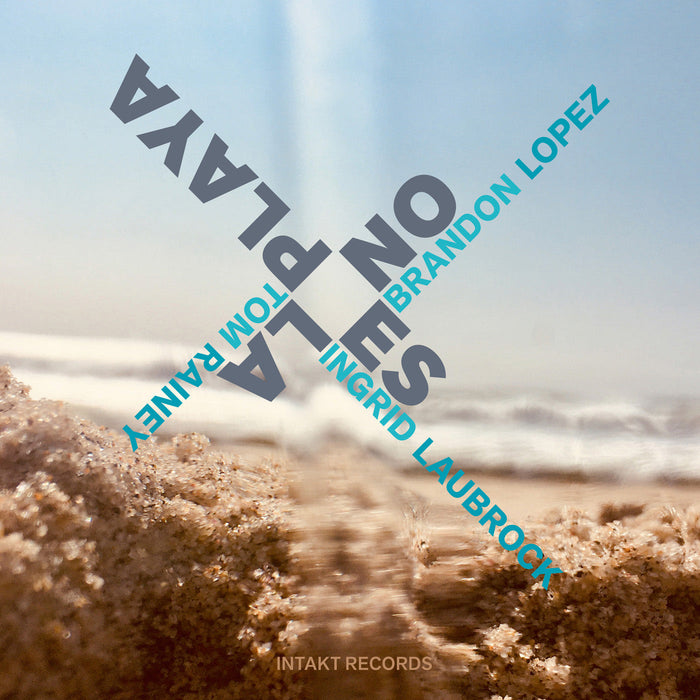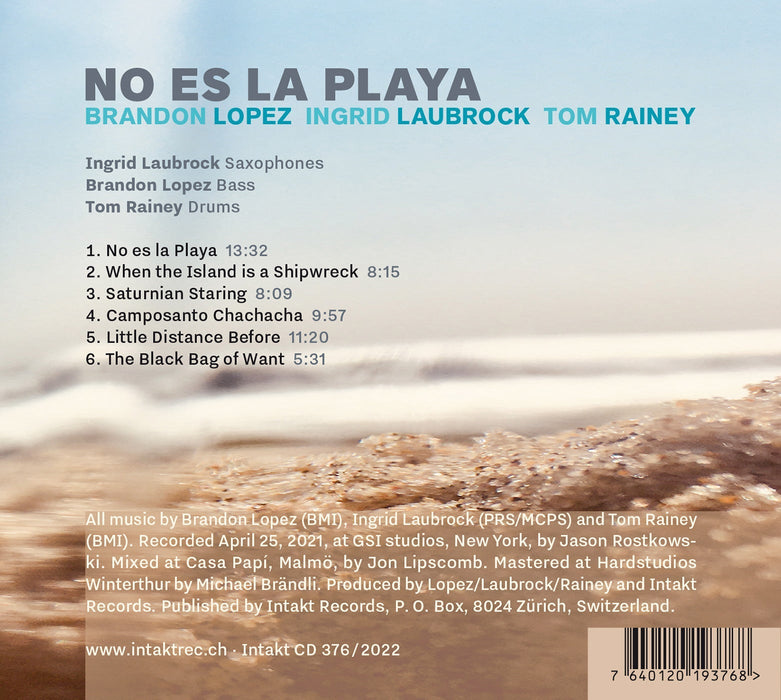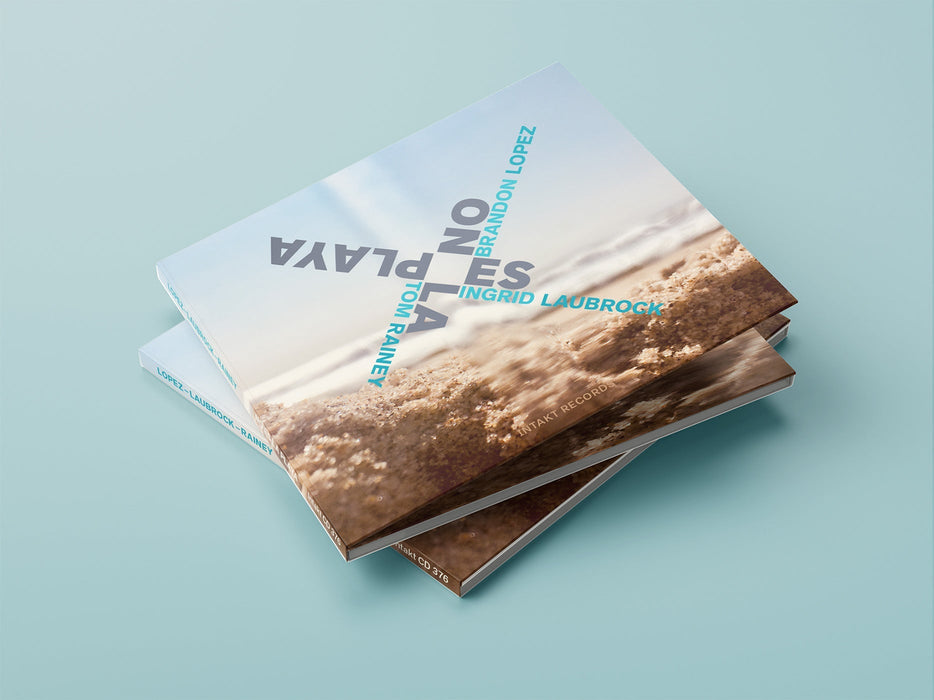


376: BRANDON LOPEZ – INGRID LAUBROCK – TOM RAINEY. No Es La Playa
Intakt Recording #376/ 2022
Ingrid Laubrock: Saxophone
Brandon Lopez: Bass
Tom Rainey: Drums
Recorded April 25, 2021, at GSI studios, New York, by Jason Rostkowski.
More Info
Dreamlike experiences. Sparks fly and a musical interaction works without arrangement or plan. An organic musical process develops out of intuition alone. The same magic happens every time.
When Brandon Lopez, a New Yorker with Puerto Rican roots, joi- ned the duo of Saxophoneophonist Ingrid Laubrock and drummer Tom Rai- ney, this wasn’t simply about adding a plus one to the Laubrock – Rainey duo. Thanks to the young bassist (born 1988), already collaborating with musicians from Dave Liebman via Zeena Par- kins to John Zorn, a new dynamic has formed involving all three. In this triangular constellation a different balance is achieved and an altered play of energies. They are clearly on the same wavelength, with a similar sense and understanding of overarching form, inner structure, timing, feeling, energy, density, transparency and volume.
"Right from the first note the chemistry between them was right. The interplay between the three worked so effortlessly and naturally it bordered on telepathy. The three want to keep up the momentum and capture the magic moment," writes Christoph Wagner in the liner notes.
Album Credits
Cover Photo: Ingrid Laubrock
Graphic design: Jonas Schoder
Liner notes: Christoph Wagner
Photo: Cecilia Lopez
All music by Brandon Lopez (BMI), Ingrid Laubrock (PRS/MCPS) and Tom Rainey (BMI). Recorded April 25, 2021, at GSI studios, New York, by Jason Rostkowski. Mixed at Casa Papí, Malmö, by Jon Lipscomb. Mastered at Hardstudios Winterthur by Michael Brändli. Produced by Lopez/Laubrock/ Rainey and Intakt Records. Published by Intakt Records, P. O. Box, 8024 Zürich, Switzerland.
The addition of bassist Brandon Lopez to the recognized duo of saxophonist Ingrid Laubrock and drummer Tom Rainey provides proof once more, though maybe not in the manner Aristotle envisaged, that the whole can be greater than the sum of its parts. The liners allude to the success of the threesome's first gig at Park Slope's Barbes in 2017, and the reasons for their satisfaction can be heard all over the outstanding, unpredictable and empathetic interchange across the six studio improvs contained on No Es La Playa.
https://www.allaboutjazz.com/john-sharpes-best-jazz-albums-of-2022
A MARVELLOUSLY inventive trio here: saxophonist Ingrid Laubrock born in Stadtlohn, Germany; Los Angeles drummer Tom Rainey and the young composer and insurgent of the bass Brandon Lopez, a New Yorker of Puerto Rican roots. Together they concoct and converse like three sonic sorcerers.
Rainey is some drummer, conjuring every conceivable surface with a transformative artistry. The New York studio engineer picks up every iota of his sound. Laubrock plays a skittering soprano saxophone on the title track: all through When the Island is a Shipwreck her tenor sax rasps, resonates and guffaws.
Alongside and below all this is Lopez’s gambolling bass. “I try to blind everything out and be totally in the moment,” he says, and such moments abound. His strings bounce sorbo-like through Saturnian Staring and his bow-work crackles in Camposanto Chachacha. The finale, The Black Bag of Want, speaks for us all: a scintillating threesome.
https://morningstaronline.co.uk/article/b/album-reviews-with-chris-searle-november-28-2022
Couple musical reconnu parmi les plus grands et les plus importants de notre temps, la saxophoniste ténor/soprano Ingrid Laubrock et le batteur Tom Rainey aiment se confronter à des invités amis (voir leur dizaine de disques chez Intakt entre autres). En voici un nouveau : le contrebassiste d’origine portoricaine Brandon Lopez. Comme souvent, ils se lancent sans filet dans six improvisations collectives, dans la lignée des grandes envolées du free jazz. Mais qu’on ne s’y trompe pas, il ne s’agit pas de retrouver le son d’une époque révolue, mais de poursuivre une certaine idée de la création. C’est une musique de maintenant, exigeante, difficile et formidablement bien jouée. Il s’en dégage une réelle fraîcheur.
https://culturejazz.fr/spip.php?article3852
Bassist Brandon López is a plangent, almost granitic presence on recordings and the live stage. His articulation and rich, oval sound stake out a broad and responsive territory in ensemble improvisations. His playing has a balance between his careful listening and the certainty of his responses. He means what he says and he says what he means. At least that is so in his playing; his words are cagier. In a recent email exchange meant to explore his musical thinking, to find out the motivations that has a musician taking on what is the artistically important but economically thankless path of jazz-based and free improvisation, he offers intriguing clues but deflects most exploration.
He has an upcoming residency at The Stone, where he will be playing a solo set one night. About the challenges of playing a solo bass concert, he writes, "the physicality of double bass technique presents a monumental challenge in solo playing. The instrument was developed to reinforce the cello section in an orchestra. It is meant to be felt, not heard. You have to be in great physical shape to get around the instrument and technique takes hours and hours of maintenance every week."
How did he pick up the bass and how did his path take him to The Stone? "I come from a musical family and from a culture that values music," López explains. "My great uncles were well respected musicians and bandleaders in Puerto Rican and Nuyorican music. I was always interested in music." But he goes on to say that "public school music class and a natural distaste for performance kept me away from an instrument until I was 12 or 13. I haven't been able to stop playing since." What happened in his early teen years that wiped away his previous distaste and how playing the bass turned into becoming an improvising musician, is "too messy for me to really comprehend or turn into a cohesive narrative. I'd rather keep from spewing bullshit and most of the information has to be banal." As to influences, he responds: "I can give an exhaustive and incomplete list, but I'd rather refrain."
Perhaps, but life is the fuel for creativity and what López imagines to be banal to others includes the things that make him the player he is. Few of us are good judges of the quality of the stories within us, whether those come out in words or in music, and the critical listener often hears things that are not only interesting but also, because they are so integrated in the source, are invisible to the musician playing them. He does listen to himself critically, however. "I consistently record and listen to myself," he explains. "It's a means to process what is and isn't working within my work. I can then, ideally, make compositional decisions and control certain impulses in the future. I don't think this is too dissimilar from boxers, football players, sport teams watching footage of past games. When your work deals with the present, recordings help in dealing with the process."
A run of recent recordings includes collaborations with saxophonist Ingrid Laubrock and drummer Tom Rainey, the Whit Dickey Trio and the sensational Moten/López/Cleaver, featuring the spoken words of poet Fred Moten and drums of Gerald Cleaver. The latter stands out for what is easily the deepest listening from López caught on record, each note shaped to give both space and full support to Moten.
Other than hinting at how he listens to himself, the bassist is resolute about not revealing his musical process. Curiosity about how improvisation for him is different than playing previously composed and notated material elicits an argument about the interviewer "centering the conversation on a particular European tradition" and the claim that musical notation, which dates back to at least around 1500 years BCE, with non-Western origins, "was developed as a means to record and sell music before there was audio recording technology." Curiosity about his approach to rhythmic structures in improvisation is returned with didactic questions as to whether the interviewer understands the meaning and history of the "jazz tradition".
He does allow, however, that he finds rhythmic synchronization through improvisation is integrated into his playing. "It happens and it happens often," he notes. "When working with great improvisers who are engaged, there's never a lack of rhythmic or formal coordination. There's plenty of recorded material that I'm part of that showcases this and it happens plenty in a live setting."
For those who care about the "jazz" tradition in the broadest sense, from the blues and 19th Century dance music to Cecil Taylor and, well, Brandon López, there are worthwhile things to explore in how musicians think improvisationally, vis-a-vis the vast head-solo-head-double bar, song-form based music from the first half of the 20th Century. But López dismisses the topic: "I don't understand how improvised music is different from 'formally structured music'. When great improvisers work there...
Saxophonistin Ingrid Laubrock und Schlagzeuger Tom Rainey sind nicht nur ein Begriff sie musizieren seit mehreren Jahrzehnten gemeinsam in einer Vielzahl von Formationen. Dazu gehören unter anderem Laubrocks letzte Veröffentlichung für Kammerorchester und kleines Ensemble, „Dreamt Twice, Twice Dreamt", sie spielen aber auch im Rahmen ihres Oktetts zusammen sowie als Teil von Anti-House, mit Sleepthief oder auch in Tom Raineys Trio und dessen Standards interpretie-rendem Quintett Obbligato allesamt unter dem Labeldach von Intakt Records. In seinem freien improvisatorischen Ansatz knüpft „No Es La Playa" nahtlos an das vergangene Werk des Duos an; neu im Bunde ist dabei Bassist Brandon Lopez. Ob mit Bogen oder pizzicato, Lopez' Spiel poltert und quietscht zu seinem eigenen Puls oder besser: Impuls. Dieses Triogefüge lebt nämlich davon. Sie sind meist spontan, aus dem Moment heraus geboren und treffen stets auf ein Echo Impulse bilden das zentrale Gewebe dieser Musik. Wer jenen avantgardistische Stil, den Saxophonist Evan Parker mitbegründet hat, zu schätzen weiß, wird auch hier auf seine Kosten kommen.
Het voorbije decennium zijn Ingrid Laubrock en Tom Rainey uitgegroeid tot het ongekroonde koningskoppel van de avant-garde jazz, een tweeeenheid met telepathische vermogens. De jongere bassist Brandon Lopez laat zich daar allerminst door intimideren. Integendeel, hij neemt letterlijk plaats in tussen de muzikanten en ontpopt zich tot een even assertieve als empathische gesprekspartner, of het nu gebeurt met strijkstok of pizzicato. Laubrock combineert tenor- en sopraansax, passeert via Braxtoniaanse staccatospurtjes en Lacy-eske uitweidingen, maar is vooral voortdurend verwikkeld in een conversatie-in-het-moment met de onophoudelijk inventieve ideeënstroom van Rainey, zoals steeds meesterlijk zonder te epateren. En als Little Distance Before maximaal gebruikt maakt van ruimte, dan is afsluiter The Black Bag of Want een kolkend orgelpunt.
This trio collaboration - of long-time partners Ingrid Laubrock and Tom Rainey on saxes and drums, joined by young Puerto Rican New Yorker Brandon Lopez on bass - emerged from an impromptu performance in Brooklyn's almost deserted Barbès bar in 2017. Laubrock and Rainey hit it off so intuitively with Lopez that their trio coalesced by osmosis rather than negotiation, on top of which this studio recording taps a fortuitously prolific seam of music-making for them in the lockdown months of shared online experimentation. All the pieces on No Es La Playa are unflinchingly non-generic free-jazzy originals, but they draw on a wide span of traditional and contemporary sonic and structural resources all three have routes into. Lustrous-toned tenor-sax reflectiveness turns to barrelling uptempo freebop over Lopez' fast bass walk and Rainey's scampering free-swing on the title piece, while the final track's 'The Black Bag Of Want' moves from an intro of slewing bowed-bass sounds snapped at by Rainey's snare hits and cantering tattoos, to a development in raw tenor multiphonics over a headlong rhythmic sprint in which Lopez and Rainey seem indivisibly joined.
In between come the squally tenor-blow 'When the Island is a Shipwreck' (ending up unexpectedly close to the Cool School's cryptic lyricism); the ethereal, tonally-nuanced soprano feature 'Saturnian Staring'; 'Camposanto Chachacha, with its freewheeling solo-tenor centrepiece and staccato closing section driven by Lopez' furiously precise bowing, and the spacious, abstract 'Little Distance Before'. No Es La Playa -'it's not the beach' - accurately defines this album's resistance to any form of indolence, but if it's often edgy free-jazzmaking, it's in a very articulate league.
Le cronache raccontano che l'11 aprile 2017, quando ancora nessuno aveva pratica concreta di una pandemia, in un locale di Brooklyn si trovarono a suonare per la prima volta assieme, in improvvisazione, Ingrid Laubrock con i suoi sassofoni, Tom Rainey alla batteria e il giovane contrabbassista Brandon Lopez, il "ragazzo" del gruppo: da Portorico, classe 1988, un presente fatto di collaborazioni importanti e tutt'altro che banali come John Zorn, Dave Liebman e Zeena Parkins. Quella sera, pare di fronte ad appena una decina di persone progressivamente coinvolte nel cerchio magico della musica, si verificò ancora una volta il piccolo miracolo dell'interplay.
Chi ascoltava ebbe l'impressione di un trio strutturato ed abituato a suonare assieme da tempo. Era scattata la misteriosa alchimia dell'intesa; parzialmente giustificata e giustificabile, forse, col fatto che Tom Rainey con le sue articolazioni poliritmiche imprevedibili è da molti anni un compagno di palco (e di vita) affidabile e telepatico della sassofonista tedesca con base statunitense in quartetti, quintetti, trii anche a suo nome. Stabilire un'intesa immediata con Lopez non era però così scontato: invece successe, perché il bassista, racconta, sa che quando approccia un incontro musicale nuovo si prepara ad avere "mente sgombra, reattiva, a concentrarsi sul momento, e a quel punto saper individuare quando qualcosa di significativo succede, e dargli spazio". Ovvero, ciò che è accaduto qui, in sei magnifiche campiture all'impronta (dai cinque ai tredici minuti e oltre) di un'intensità gioiosa, schiumante, quasi "fisica". Fatta di incastri sorprendenti, come tessere di un puzzle complesso sì, ma splendido.
Zoals de cd-titel aanduidt, is dit geen daguitstapje naar zee maar eerder een trip naar de marge van de New Yorkse jazz- en improvisatiescene. Saxofoniste Ingrid Laubrock en drummer Tom Rainey nemen samen met bassist Brandon Lopez de luisteraar op sleeptouw door een wirwar van achtersteegjes waar uit alle ramen en kelderverdiepingen flarden muziek klinken.
Soms gaat het langzaam voortschrijdend om vervolgens tegen helse snelheid vooruit te stormen. Continu wisselen ondefinieerbare geluiden en trillingen af met plotse energieke opstoten. Het trio wentelt en worstelt zich haast in extase door dit zelf gecreëerde labyrint. Knap hoe ze bijvoorbeeld in ‘Little Distance Before’ aanvankelijk elk in hun hoekje ideeën uitbroeden en vervolgens omzichtig toenadering zoeken.
Laat u bij dit alles vooral niet misleiden door een titel als ‘Camposanto Chachacha’. Zes routes in totaal die in lengte variëren tussen vijf en dertien minuten. Sfeer en actie als elkaars yin en yang.
https://www.jazzhalo.be/reviews/cdlpk7-reviews/various/intakt-special/?fbclid=IwAR2LyMEUCDf9X9AZT_l9w8mll8Wi10GPfu2tqQlQzWKIEloK0ltFVq-jyfo
„Es ist nicht der Strand“, sondern ein Ozean voller Melodien und Rhythmen. Alles improvisiert. Jedoch gibt es wohl wenige Musikerinnen wie Ingrid Laubrock, die die Kunst beherrschen, im Moment zu komponieren bzw. eine Improvisation so zu gestalten, dass sie Struktur und Tiefe hat. Mit Tom Rainey und Brandon Lopez
gesellt sich eine Rhythmusgruppe dazu, die in der Lage ist, das mitzugehen und selbst auch Verantwortung zu übernehmen. Das Duo Laubrock/Rainey arbeitet seit Jahren in vielen Projekten zusammen, zuletzt in ihrem Lockdown-Duo-Projekt Stir Crazy Series auf Bandcamp. Sehr zu empfehlen. Lopez schafft es mühelos,
sich in dieses eingespielte Team einzugliedern und es zu mit seinem Bassspiel zu bereichern. Alle Tracks haben einen guten Zug und eine feine Dramaturgie. Nach fast einer Stunde ist die CD plötzlich zu Ende, und ich kann mich nicht erinnern, wann ich das letzte Mal so kurzweilige Improvisationen gehört habe. No es la playa aber ein großes Vergnügen
